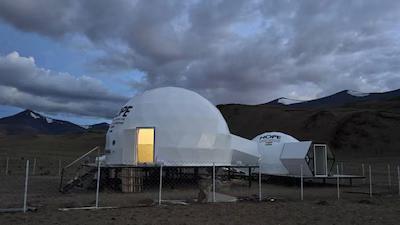
ISRO Sets Up Station in Ladakh to Simulate Life on Moon & Mars
In a significant development, the Indian Space Research Organisation (ISRO) has set up the Himalayan Outpost for Planetary Exploration (HOPE) in Ladakh’s Tso Kar Valley. The state-of-the-art facility will serve as a testing ground for life-support systems required for future lunar and Martian missions. The unique environment of the valley, with its high UV radiation, low atmospheric pressure, extreme cold, and saline permafrost, makes it an ideal location to simulate the conditions of Mars.
The HOPE station, located at an altitude of 4,500 meters, is designed to mimic the harsh environment of Mars, which is a key challenge for any mission to the Red Planet. The station will be operational for a period of 10 days, from August 1 to 10, with two crew members undertaking various tests and experiments during this time.
The crew members will be testing the life-support systems, including air, water, and food supplies, as well as the psychological and physical effects of living in a confined and isolated environment. The data collected during this simulation mission will be crucial in helping ISRO design and implement the necessary systems for future human missions to the Moon and Mars.
The choice of Tso Kar Valley as the location for the HOPE station was deliberate. The valley’s extreme environment, with temperatures often dropping to -20°C, is similar to that of Mars, which has average temperatures ranging from -125°C to 20°C. The high UV radiation and low atmospheric pressure in the valley also closely resemble the conditions found on the Martian surface.
“The valley’s environment is quite challenging, with extreme cold, low oxygen levels, and high UV radiation. These conditions will help us simulate the Martian environment and test our life-support systems,” said S. Somanath, Director, ISRO’s Human Spaceflight Centre.
The HOPE station is equipped with state-of-the-art facilities, including a modular habitat, life-support systems, and communication equipment. The crew members will be living in the station for the duration of the simulation mission, with all their needs met through the life-support systems.
The success of this simulation mission will pave the way for ISRO’s future human missions to the Moon and Mars. The agency is planning to send its first human mission to space by 2022, with the aim of establishing a permanent human settlement on the Moon by 2030.
ISRO’s efforts to simulate life on the Moon and Mars are not limited to the HOPE station. The agency has also established the Space Sciences and Technology Centre (SSTC) in Bengaluru, which is working on developing technologies required for human missions to the Moon and Mars.
The SSTC is developing advanced life-support systems, including air and water recycling, as well as advanced communication systems and navigation technologies. The centre is also working on developing materials and equipment that can withstand the harsh conditions found on the Moon and Mars.
ISRO’s efforts to explore space are not limited to the Moon and Mars. The agency is also working on sending missions to Venus, Jupiter, and the outer planets of the solar system. The HOPE station is an important step in this direction, as it will help ISRO develop the necessary technologies and expertise for future missions.
In conclusion, the Himalayan Outpost for Planetary Exploration (HOPE) station in Ladakh’s Tso Kar Valley is a significant milestone in ISRO’s efforts to explore space. The simulation mission will help ISRO develop the necessary technologies and expertise for future human missions to the Moon and Mars. The success of this mission will pave the way for ISRO’s future endeavors, including the establishment of a permanent human settlement on the Moon.






